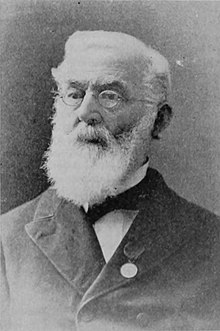Author:James Hall (1811-1898)
Jump to navigation
Jump to search
Works[edit]
- A catalogue of plants, growing without cultivation, in the vicinity of Troy with John Wright, 1811-1846; 1836 (external scan)
- Natural history of New York (1842) with others part 1, part 2, part 3-4, part 5-6
- Tables of organic remains, 1843 (external scan)
- Niagara falls, 1844 (external scan)
- Exploration and survey of the valley of the Great Salt Lake of Utah. With others. 1852 (external scan)
- Descriptions of new species of fossils: from the cretaceous formations of Nebraska, 1856 (external scan)
- Key to a chart of the successive geological formations, with an actual section from the Atlantic to the Pacific ocean, 1852 (short work) (external scan)
- Report on Canadian graptolites, 1858 (short work) (external scan)
- Figures and descriptions of Canadian organic remains, 1865 (external scan)
- Organic remains of the Niagara group and associated limestones, 1871 (external scan)
- On the relations of the Niagara and Lower Helderberg formations, and their geographical distributions in the United States and Canada , 1874 (short work) (external scan)
- Illustrations of Devonian fossils: corals of the Upper Helderberg and Hamilton groups, 1876 (external scan)
- Note on the Eurypteridae of the Devonian and Carboniferous formations of Pennsylvania. Second Geological Survey of Pennsylvania. Report of Progress. Volume PPP (1884)
- Report on building stones. 1886 (short work) (external scan)
- An introduction to the study of the genera of Palaeozoic Brachiopoda. With John Mason Clarke, 1857-1925 (1892) part 1, part 2
- A memoir on the Palaeozoic reticulate sponges constituting the family Dictyospongidae, 1898 Vol 1, vol 2
Articles in Popular Science Monthly[edit]
Works about Hall[edit]
- "Sketch of Professor James Hall" in Popular Science Monthly, 26 (November 1884)
- "Hall, James (geologist)," in Encyclopædia Britannica (11th ed., 1911)
![]()
Some or all works by this author were published before January 1, 1929, and are in the public domain worldwide because the author died at least 100 years ago. Translations or editions published later may be copyrighted. Posthumous works may be copyrighted based on how long they have been published in certain countries and areas.
Public domainPublic domainfalsefalse
